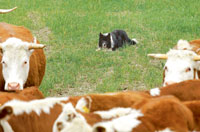Avoid the risk of dogs spreading neospora in your herd

Think cattle abortions and BVD is probably the disease that comes to mind, but recent research has identified neospora as the top pathogen in abortion samples, with BVD only the fourth most common.
According to research scientist Frank Katzer from the Moredun Research Institute, two studies carried out by Moredun and SAC detected neospora in 22.9% of abortion cases. And within these positive samples, 35.2% of the pathogens present were neospora.
“Farmers are generally not aware of neospora, but infection with the protozoan parasite can have huge implications in terms of increased abortion rates and calf survival.”
The main clinical sign of neospora infection in cattle is abortion, explains Dr Katzer.
“A recent study published in the Vet Record, found neospora-positive heifers were 5.3 times more likely to abort in first pregnancy and six times more likely to abort in second pregnancy compared to negative animals.”
And positive heifers were also four times more likely to give birth to a dead calf or a calf that died within 24 hours of life.
How is it spread?
Neospora infects cattle by two routes:
• When faeces from an infected dog get into cattle drinking water or feed and are ingested by the cow.
• When a neospora-positive animal becomes pregnant, the disease can spread across the placenta and infect the calf, either causing an abortion or producing a persistently infected animal
The dog is the only confirmed host in the UK that can transmit neospora and is needed for the disease to spread to cattle, explains Dr Katzer.
Dogs become infected when they consume infected cattle abortion material or placenta. Eggs are then produced in the dog’s digestive tract and shed in the faeces, remaining stable in the environment for about six months.
When this infected material is ingested by cattle via contaminated feed or water, the animal will then become infected.
“After a cow is infected in the first trimester of pregnancy she is highly likely to abort,” says Dr Katzer.
“However, when infection occurs in the second trimester, a proportion will abort while most others will produce persistently infected (PI) calves.”
A PI calf may appear weaker and have walking problems. They are also likely to abort when they become pregnant or produce neospora positive offspring. “A PI cow may produce a PI calf initially, but she can also give birth to a healthy calf later.
“When a naïve animal becomes infected with the parasite, they will be infected forever. An infected dam can transmit neospora to its calf for a lifetime, but she doesn’t have to,” explains Dr Katzer.
“This may be linked to the initial level of infection and how much of the pathogen is available to be reactivated in each pregnancy,” he says.
When a positive animal is not pregnant, the parasite sits in a “dormant” stage in intracellular cysts throughout the body. But when she becomes pregnant again, these become reactivated and are capable of infecting the unborn calf.
However, there is no evidence of adult cow to cow transmission, so when a farm is enclosed, with no dogs present, even when an infected cow is introduced to a naïve herd, there is no risk of infection, although imported feed or water can pose a risk.
But when a recently infected dog is bought onto the farm or a neospora-positive cow is introduced onto a farm with dogs, there is risk of the disease infecting the herd.
Testing and control
The key to preventing neospora from entering the herd is to control access of dogs to potentially infected material, cattle feed and water sources, says Dr Katzer.
“Initial infection is the main issue – once it is on farm it is difficult to control as there is no vaccine available in the UK.” Wormers are also not effective against neospora in dogs.
Once analysis of placenta and abortion material has identified neospora as a significant cause of abortion, blood testing is the next stage.
“When neospora is the main cause, bloods from recently aborted cows should test positive.”
However the main challenge with neospora is the fact an animal can be positive for the disease, but test antibody-negative.
A whole-herd blood test can be used to determine the neospora status of all stock, but producers should be aware that there is the potential to miss some infected animals. Culling is then an option, but will depend on the level of infection in the herd.
Regular testing of new-born heifers should be introduced as part of a health plan to prevent positive animals being used as replacements, says David Harwood, VLA.
“Bloods should be taken in the first one or two weeks after birth to see whether an animal is congenitally infected..
“It will depend on specific risk factors and a farmer’s priorities as to whether testing is relevant – the key is preventing initial infection.”
However, farmers that have experienced neospora abortion storms do not need to get rid of their dogs, says Dr Katzer.
“Once a dog has become infected, it will shed eggs for a couple of weeks and will then stop, becoming immune to new infection.”
But, efforts to reduce faecal contamination of pasture by dogs is crucial, says Nigel Miller, NFU Scotland vice-president.
“For those walking or working dogs in the country, there is a need to recognise the danger their animals pose and ask them to collect and deposit all faeces.
“All fallen stock should be disposed off promptly and where practical, placental material collected to reduce the risk of consumption by dogs,” Mr Millar says.
For more on this topic
Read about how the BBC radio show The Archers incorporated neospora into a storyline
